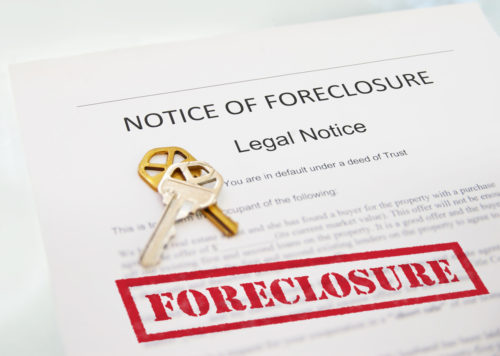If you just received a notice of default by mail or phone, you may feel confused, scared, and anxious about the next steps. These official communications usually sound threatening and stern so it’s no wonder you’re apprehensive about what’s to come. Your home mortgage lender sends this notice if you’re behind on payments and it’s important to evaluate your options and take action.
A notice of default is the first step in the foreclosure process but you don’t need to worry about losing your home just yet. Reviewing the foreclosure process timeline and the potential consequences of skipping another payment may help you better understand your options.
Table of Contents
What Is a Notice of Default?
A notice of default is a notice that’s publicly filed to notify a borrower that they’ve missed payments and are officially in arrears on their home loan. This notice is also commonly referred to as a notice of foreclosure, reinstatement period, or notice of public auction. The number of loan payments you can miss before you receive a notice of default varies by lender and is outlined in your mortgage documents.
Before filing a notice of default, your lender is required to reach out when you’re 45 days late on your mortgage payment. The lender must offer assistance, such as a payment plan, at this time and cannot legally take action against you until your payment is at least 120 days late. However, some states, such as California, have additional legislation pertaining to default notices and require lenders to contact the borrower after a payment is only 30 days late.
Your home is collateral for your loan, so missing payments puts your homeownership in jeopardy. However, a notice of default doesn’t mean your home is in foreclosure. It means your creditor has noticed you’re behind on your mortgage payments and will take action if you don’t address the issue quickly. You may be provided with a negotiation period that allows you to catch up on payments before the lender takes the next steps toward foreclosure.
Stay Watchful for Foreclosure Scams
Your notice of default may be delivered by mail or you may receive a phone call from your lender. However, there are scams related to notices of default and foreclosure proceedings, so it’s important to know how to verify the validity of the claim.
If you receive a phone call from your lender, ask pertinent questions to ensure it’s not a fraudulent call. Ask for the company name and make the caller verify the bank’s phone number, as well as the amount that you owe.
If it doesn’t seem legitimate, don’t give the caller any information. If the notice came in the mail, review your details and the creditor’s information and logo for validity. Don’t respond or send money unless the address and details match your lender’s information.
Understand Foreclosure Laws
The foreclosure process is different in every state so it’s important to review your state’s foreclosure laws if you receive a notice of default. Generally, your lender must wait three to six months after you begin missing mortgage payments to proceed with foreclosure.
If you ignore the notice of default and other official communications from your lender, the creditor is more likely to accelerate foreclosure proceedings against you. However, your lender is still required to follow state law and timelines associated with your case.
What Are My Rights?
There are several federal regulations in place that protect borrowers from aggressive lenders. This legislation ensures borrowers have ample time to address their lender’s concerns before the foreclosure process begins.
Foreclosure Timeline by State
State foreclosure timeline regulations generally delegate the length of a foreclosure from initiation to finalization. These timelines are as follows:
| State | Months | State | Months | State | Months |
| Alabama | 4 | Kentucky | 7 | North Dakota | 10 |
| Alaska | 7 | Louisiana | 6 | Ohio | 12 |
| Arkansas | 5 | Maine | 22 | Oklahoma | 7 |
| Arizona | 4 | Maryland | 6 | Oregon | 7 |
| California | 7 | Massachusetts | 8 | Pennsylvania | 10 |
| Colorado | 7 | Michigan | 9 | Puerto Rico | 14 |
| Connecticut | 9 | Minnesota | 12 | Rhode Island | 3 |
| Delaware | 8 | Mississippi | 4 | South Carolina | 7 |
| Washington, D.C. | 7 | Missouri | 3 | South Dakota | 10 |
| Florida | 9 | Montana | 9 | Tennessee | 4 |
| Georgia | 4 | Nebraska | 6 | Texas | 3 |
| Hawaii | 9 | Nevada | 7 | Utah | 5 |
| Idaho | 9 | New Hampshire | 4 | Vermont | 17 |
| Illinois | 13 | New Jersey | 14 | Virginia | 5 |
| Indiana | 12 | New Mexico | 7 | Washington | 6 |
| Iowa | 17 | New York | 13 | West Virginia | 5 |
| Kansas | 12 | North Carolina | 5 | Wisconsin | 12 |
| Wyoming | 6 |
In Michigan, the foreclosure is only considered complete after the redemption period has expired.
What Are Your Options When You Receive a Notice of Default?
If you receive a notice of default, begin exploring your options so you may potentially avoid foreclosure.
Contact Your Lender
It’s important to contact your lender as soon as you receive a notice of default. If you don’t communicate with your lender right away, they could assume you’re ignoring the notification. Your lender is more likely to proceed with the foreclosure if it doesn’t seem that you want to resolve the debt you owe.
If you contact your lender, they may be willing to work with you on the payments you owe, especially if you’ve recently experienced a financial hardship. Your lender may be able to put you on a more lenient payment plan or forgive some of your late payment fees to help you catch back up on your mortgage payments.
Seek Out a Housing Counselor
If you feel overwhelmed by your financial situation, contact a HUD housing counselor to discuss your options. A housing counselor is an expert on housing expenses and dealing with lenders and may be able to offer you free or affordable advice on how to get back on your feet. After analyzing your income and budget, the housing counselor will offer suggestions or provide you with access to resources that will make it easier to afford your mortgage and avoid foreclosure.
How to Improve Your Credit After a Foreclosure
If your lender proceeds with a foreclosure, your credit score will be negatively affected for years, making it hard for you to qualify for another mortgage for a new home. A foreclosure will remain on your credit report for seven years, but the negative effects it has on your score will begin to diminish throughout this time period.
To build up your score during this time, keep your debt-to-income ratio low and continue paying your bills on time. You may only file to have the foreclosure removed from your credit report early if it was falsely reported by your lender.
If you receive a notice of default, it doesn’t mean your home is immediately going into foreclosure. However, it’s important to address the financial issues you’re having with your lender and get back on track with your mortgage payments to avoid foreclosure proceedings.
Image Source: https://depositphotos.com/





